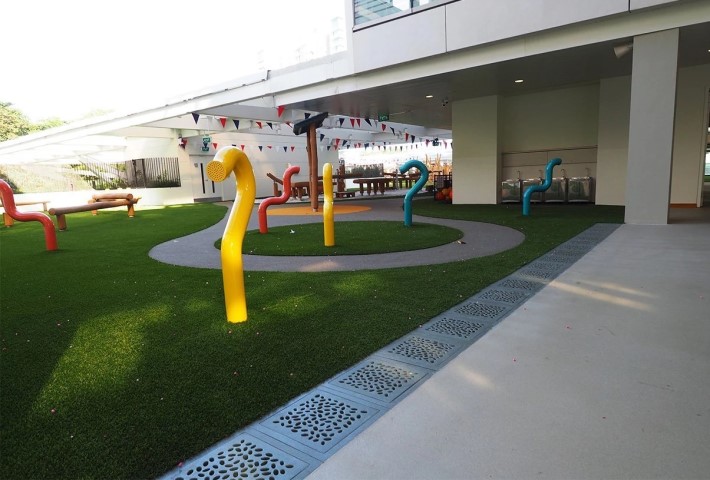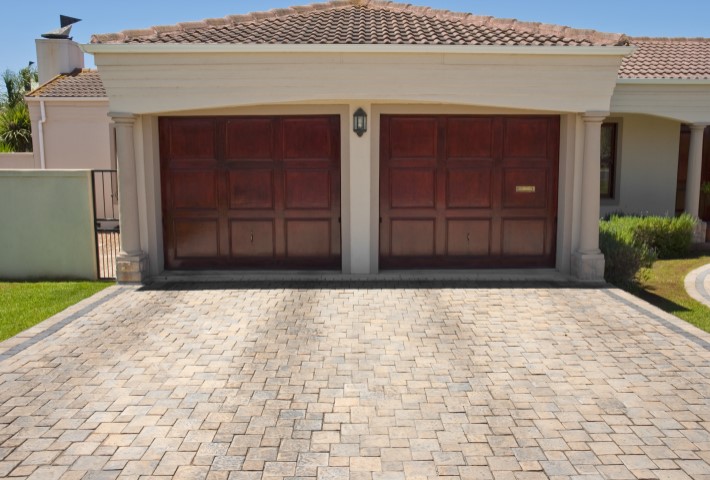Channel drains are one of the most effective and widely used drainage solutions. The drains, along with their grating, are a central piece of many residential and commercial developments. Together, they prevent an area from being swamped with water while still allowing the area to remain accessible.
However, not all channel grating is the same. This is a broad category that covers a lot of different types, materials, and compositions. Each of these is useful or preferable, depending on the situation.
There are two main ways to classify channel grating. The first and more common method is classification by the material the grating is made from. However, you can also separate types of channel grating by their slot designs.
Let’s look at some of the most common types of channel grating based on material and slot style.
Channel Grating Basics
What Is a Grated Channel?
Channels or trenches are an efficient way to drain water from an area quickly. These linear drains can be used in a variety of applications. Most of the time, these channels are covered with a grating. When the trench drain is installed with a grated cover over it, it may be known as a grated channel.
Grated channels are effective on their own or as part of a larger system. A channel may be a singular line of defence that allows water to drain away from a walkway. It also may be a feature that connects several larger drains.
These gratings can be made in several ways. Sometimes metal is welded together in order to form a grate, like something you might see on the streets. Alternatively, gratings can be moulded or cut so they have openings within a larger slab of stone or concrete.
 Channel grating allows drainage to occur efficiently under the surface while still allowing full use of the area.
Channel grating allows drainage to occur efficiently under the surface while still allowing full use of the area.
What Is the Purpose of Grating?
This grating is critical to the function and usability of the channel drain. The drain needs to have some sort of exposure in order to take in water. A grating allows water to pass through without leaving the channel totally uncovered.
Without the grating, the channel would literally be a ditch. While this might be fine in some remote or inaccessible places, it would not work in places frequently traversed by pedestrians or vehicles. This prevents a serious hazard, as people could trip and fall, or vehicles could get stuck or damaged.
The grating provides a surface to rectify this problem. People can easily walk over it, and vehicles can drive over it without the possibility of harm.
For example, a channel drain is an ideal way to prevent water from pooling in a driveway and making its way into your garage or home’s foundation. But you also need to be able to get your car over the channel. Trench grating makes it simple to cover the channel, allowing easy movement without blocking water flow.
Common Types of Channel Grating
Plastic (HDPE)
Plastic channel gratings are lightweight and affordable. Because they are easy to cast and install, they have become very popular in a variety of applications.
Unfortunately, plastic gratings can become discoloured or bleached very quickly. In addition, if they come into contact with chlorinated water, the chlorine can cause damage. Because of this, it is not usually recommended to use them around pools and similar installations.
Plastic gratings have a low load-bearing capacity compared to other types of channel gratings. Because of this, it’s recommended that they should only be used in low-traffic areas or for decorative purposes. For instance, a homeowner looking for a very inexpensive grating may opt for plastic gratings.
Cast Iron and Ductile Iron
Cast iron and ductile iron are two traditional options, also known collectively as “grey iron” These materials have excellent strength and durability. In addition, they have high load-bearing and vibration-damping capabilities. This means that even under high compression, they will not become deformed.
Cast iron and ductile iron gratings are anti-corrosive and widely available. They are suitable for use in high-traffic and municipal areas.
Stainless Steel
Stainless steel is a tough, reliable material with a high load-bearing capacity. It’s resistant to chemicals and high temperatures. Because of this, it’s useful in areas that need to ensure high levels of sanitation, such as industrial applications.

Metal channel gratings offer some benefits, but also have their downsides. ©BespaliyA | https://depositphotos.com
Carbon Steel
Carbon steel gratings are very strong and have a high load-bearing capacity. Plus, they are relatively affordable.
Unfortunately, carbon steel is not resistant to corrosion. Because of this, the material should not be used in wet, humid, or rainy environments. Instead, carbon steel gratings are better used in indoor and sheltered applications.
Aluminium
Aluminium channel gratings are quite strong but not as strong as steel. Aluminium does not rust, making it good for wet outdoor spaces. For example, aluminium gratings are sometimes used around playgrounds, pools, and water parks.
However, it does heat up and can become too hot for little feet when high temperatures are out. In addition, aluminium generally costs more than steel or cast iron options. This relegates it to more commercial applications.
Fibreglass
Fibreglass gratings are very strong and have a long life span. They are corrosion and abrasion-resistant and have high slip resistance.
Fibreglass is lightweight, giving it a variety of uses. It’s suitable for many locations, including indoor industrial workplaces, facilities, and storage rooms.
Concrete
When discussing concrete in gratings, we’re talking about the grate that covers the opening of the channel. This can be quite confusing as some channels are also made of concrete. For instance, you can have a concrete channel drain with reinforced stone grating. Or you could have a concrete channel drain with a concrete grating over the open channel.
Concrete gratings are commonly used, though many other materials are pushing them out of the way. It ranks lower than cast iron in usability, performance, and ease of operation. In addition, concrete gratings are quite heavy, making it difficult to maintain the channel underneath.
A lot of manual labour is necessary to create concrete grates. However, concrete channel gratings are flexible in terms of slope, size, depth, and other features.
They should be reserved for applications where access is not needed to the channel very often. In addition, they can usually only be used in cases where a larger budget is available.
Reinforced Stone
Reinforced stone channel gratings benefit from the durability and strength of stone as they are made with integrated stone polymers. This allows them to withstand difficult conditions, such as freeze-thaw cycles and heavy rainfall.
Reinforced stone is rust and corrosion-resistant, sustainable, and long-lasting. It has a higher slip resistance than many other materials and absorbs less heat. This makes it perfect for applications near pedestrians and even around parks and pools.
Reinforced stone channel gratings can be used in industrial and municipal applications because of their durability. Their relative affordability compared to their benefits mean they are within the budget for municipalities, commercial businesses, and even residential uses.
Reinforced stone maintains the natural beauty of stone. Plus, a wide variety of decorative choices are available, allowing it to blend well in any aesthetic environment.

Flooding can become a serious hazard on roadways. Proper grating and drains can keep these areas safe and dry. ©Prostock | https://depositphotos.com
Types of Channel Grating by Slotting Style
Longitudinal/Slotted Grating
Longitudinal or slotted grating is the traditional option. With this style, bars are placed parallel in a frame. There are large gaps that allow a lot of water to pass through. This makes them ideal for heavy flow areas.
Slotted grating is available with reinforced stone grating from Jonite. This collection offers parallel slots that are close enough to prevent most debris from entering.
Our slotted collection is perfect for various locations, including home drains, outdoor landscape drains, and even commercial and industrial purposes.
Mesh Grating
Mesh grating is usually made from metal. Bars are set in a criss-cross arrangement. This keeps much more debris out of the channel while still allowing large volumes of water to pass.
Mesh grating is stable and long-lasting. This makes them great for areas where vehicular traffic might pass, such as garages.
Diagonal Slotted Grating
This type of grating features diagonal bars that form slots. It’s useful in areas with high water flow that comes from multiple directions. For example, you may want to install it near pools or garden paths. It’s also beneficial for sloped areas.
Solid Grating
Solid grating has the smallest openings of these slotting styles. This type of channel grating features mostly solid slabs with one slit for the liquid to escape. They are heavy-duty and skid resistant. They work great in commercial applications such as workplaces.
High-Performance Grating
If your grating needs to endure heavy loads, such as those at driveways and car parks, you’ll want to consider high-performance grating. When paired with l-trimmers, you can ensure level and strong seating.
Decorative Slots
The slots in your grating don’t need to be simple. Our reinforced stone channel gratings are available in a wide variety of slot designs. For example, our avant-garde collection offers abstract rain motifs. Meanwhile, the nature collection is stylish and offers a unique point of interest for landscapes and architecture. Plus, there are many other options.
Channel gratings with decorative slots are ideal for highly visible applications.
 Channel grating and drainage is an effective way to keep excess water off of driveways. ©Heinschlebusch | https://depositphotos.com
Channel grating and drainage is an effective way to keep excess water off of driveways. ©Heinschlebusch | https://depositphotos.com
Channel Grating Considerations
When choosing the best type of channel grating for your drains, it’s important to pay attention to a variety of factors. First, you’ll want to choose which material, as this may narrow down what slot style options are available.
Start by considering the purpose and where your channel gratings will be installed. If the area receives a lot of excess water, prioritising water flow is important. Certain gratings may also be exposed to adverse conditions.
For example, if you are in an area where freeze-thaw cycles are common, choosing a material that can stand them, such as reinforced stone, is critical. Some materials are also better at avoiding water absorption and are more resistant to chemicals such as chlorine.
Once you choose the ideal material, you can find a supplier that offers that type of material. They will also help you walk through the next set of choices you will make. For instance, Jonite is a premier supplier of reinforced stone grating.
After this, you can start to consider slot design. This has the potential to be a tricky part of the process, as there are many different options that all have a rather large impact on the final product. A lot of large slots help water flow efficiently. However, many large slots will make the grate more difficult to walk over, especially for anyone wearing heels.
When making this choice, consider who will pass over the grate and how much water it will take on. In addition, consider if the area needs to be wheelchair accessible. These factors will help inform your decision.
Finally, consider if you need customisation. If you need grates with unique curves or ones that match other landscape grates, you will have to find a company capable of addressing these concerns. At Jonite, we offer custom creations, so we can help you design custom gratings that meet all of your needs.
What Is the Best Type of Channel Grating for Your Project?
If you need channel grating, you’ll be met with various choices. There are many different types of channel grating based on the material you choose. Jonite’s reinforced stone is one of the stronger yet more beautiful options that can be used in many applications.
You can also choose the best type of channel grating based on the slot style. Your decision here should consider both the practical drainage needs and aesthetic desires. Our custom design team can help you make the best choice.
Are you ready to get started choosing the ideal type of channel grating for your next drainage project? Contact the experts at Jonite today!










